How to Make Rotisserie Chicken at Home: Thermal Tips
Is there anything a rotisserie chicken can’t do? It has become the Swiss-army knife of the home kitchen. Delis and meat departments of even moderately-stocked supermarkets now sell them in little characteristic bags or plastic carriers, and they have woven themselves into the fabric of the American dinnertime. They are used for chicken salad, chicken tacos, chicken enchiladas, chicken croquettes, and, yes, they are used as roast chicken.
Here, we’ll look at what it takes to make your own rotisserie chicken at home. Yes, the rotisserie is a specialized piece of equipment that not everyone has, and we acknowledge that fact, but if you have a rotisserie for your grill—or even a stand-alone rotisserie oven—we have the temperature tips you need to make a bird that far outshines than the ones at the store.
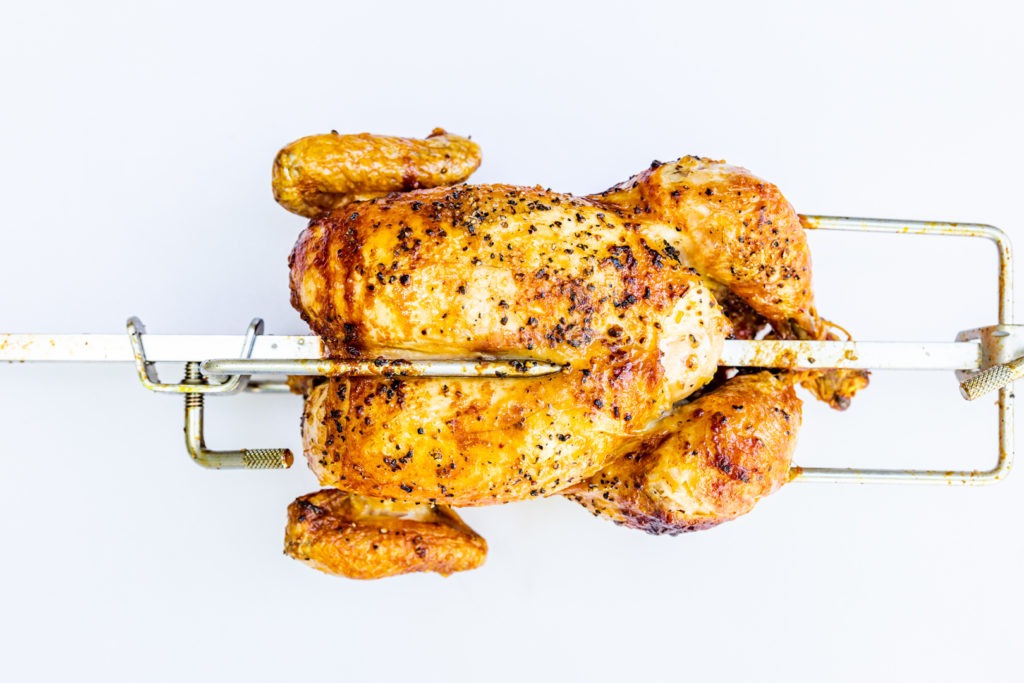
Get the temperature tools you need here:
Why cook a rotisserie bird at home?
Store-bought rotisserie chickens are the very apex of convenience. They’re relatively cheap and they’re ready to go when you need them. So why make one at home? Well, control, for one thing. You can get the highest quality chicken available, one that hasn’t been injected with a 5% solution of whatever they wanted—maybe even a heritage breed chicken from your local farmers’ market. The point is, you can get a chicken you trust.
But beyond that, there are other advantages to home-cooking a rotisserie chicken. Seasoning, for one, which you get to customize. The smell, which you get to fill your neighborhood with. And, of course, the skin.
When you buy a rotisserie chicken at the store, unless you get it super fresh and get it home super fast, the skin is going to lose its crispness. It’ll still be well seasoned, but it won’t have the bacon-y crunch that a home-spun chicken will. And oh, what skin! The constant self-basting of the rendering fat gives the bird a deep, russet gold and a crispness that plays so well against the rich fattiness. It’s a culinary delight of tremendous caliber.
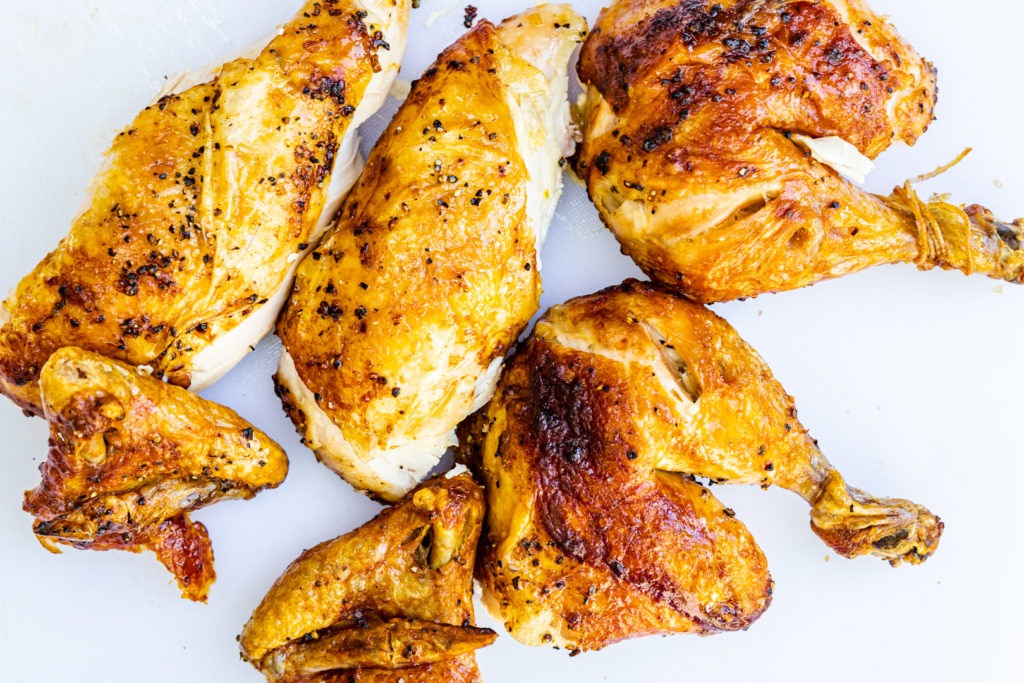
Is it as convenient as a store-bought bird? No way! But convenience isn’t why you love grilling and barbecue, is it? And this chicken is worth the (still rather small) effort.
White vs. dark meat: a thermal play
Just like on a turkey, the light and dark meat of a chicken are best cooked to two separate temperatures. Light breast meat is like a steak—tender, lean, and better if not overcooked—while dark thigh meat is more like a chuck roast or brisket, full of connective tissue that needs to be broken down, but juicy and tender once it’s properly done.
White meat is best cooked to a pull temp of about 157°F (69°C) so that it doesn’t dry out, but thigh and leg meat is better around 175°F (79°C) or higher. While that wide temperature difference may not always be achievable, there is a trick that we can use to get quite close: ice the breasts.
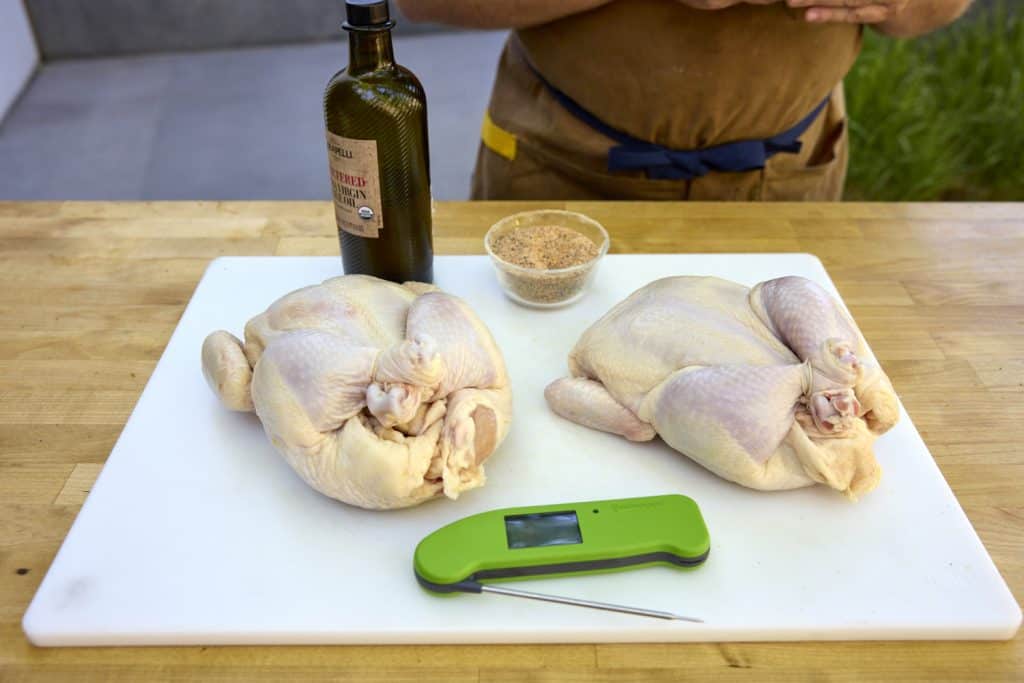
By letting the chicken sit on the counter with a bag of ice on the breasts for a half-hour or so before you cook, you allow the thigh meat to come up to a warmer temperature while maintaining a colder breast temp. The temperature differential you achieve before roasting will carry through some of the cook, so that the breasts end up cooler than the thighs in the finished bird, as well—an ingenious little trick.
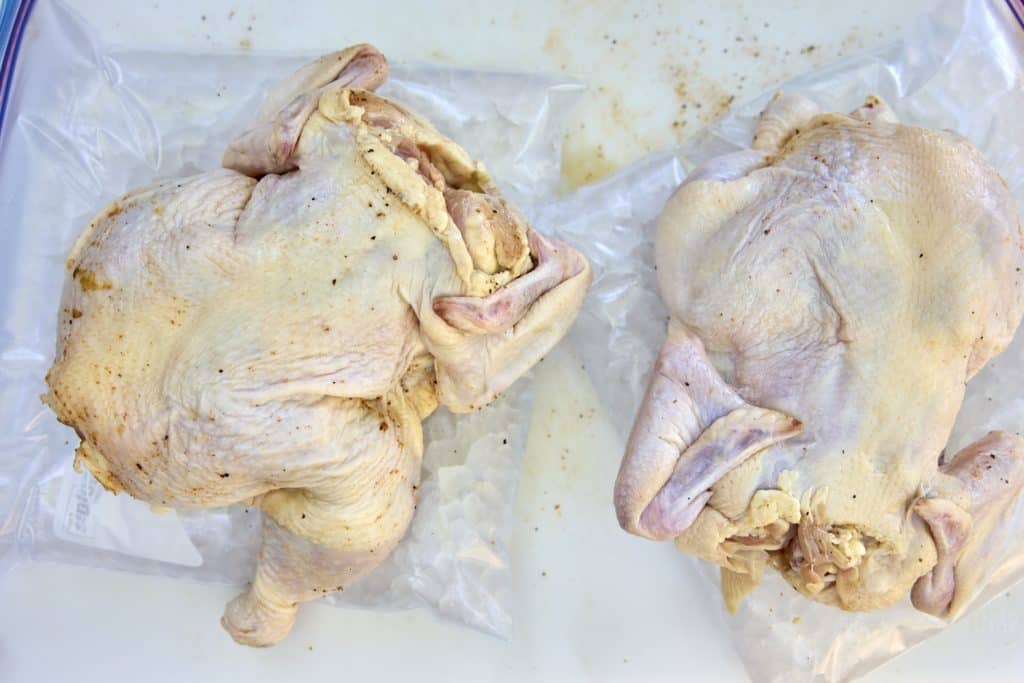
When it comes to gauging the doneness of both the breast and the thigh meat, remember that slitting the meat open to check if the juices “run clear” is not an accurate way to ever check a chicken! Using a fast and accurate thermometer, however, most definitely is.
How to season a rotisserie chicken
There’s no set seasoning for a rotisserie chicken, so you can use your imagination to season yours according to what you like. We seasoned ours just with simple salt, pepper, and lemon zest, and in many ways, that’s about as good as it gets! Not only is that flavor combination excellent on its own, but it also goes well with anything you might want to use the chicken for, later on. It will go into a Greek pita as well as it will a Mexican tortilla soup.
No matter how you season it, be sure to get some seasoning under the skin of the breasts. Doing so provides a deeper flavor to both the meat and the skin.
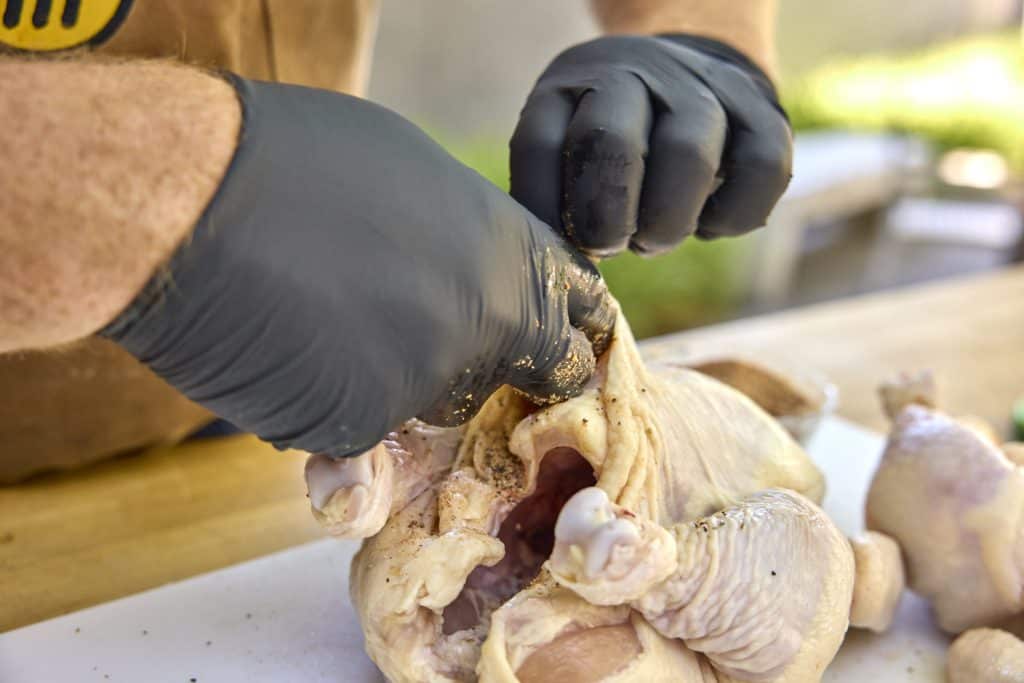
Note: a quick rub with some olive oil on the skin will also help it crisp up and brown better.
How to cook a rotisserie chicken
First, set up the rotisserie according to its instructions. In our case, that meant heating the whole grill on high, including the rotisserie burner, for about 15 minutes, then turning off the center burners (the ones right under the chicken) and turning the outside burners to medium/medium-high. Some may balk at the idea of this indirect cooking, but think back to your ideas of what a rotisserie is like. If you’re thinking of the same images that I am, then the meat is often suspended a few feet above a live fire. It’s not hot enough to scorch it immediately if the spinning stops, and we want the same basic environment here.
(If you’re using a charcoal grill, have two piles of charcoal, one on each side of the chicken, but none directly beneath it. The same high-but-indirect heat is still what you want.)
With the grill prepared, skewer your chicken with the spit and hold it in place with the proper instruments, like the tines that we used here.
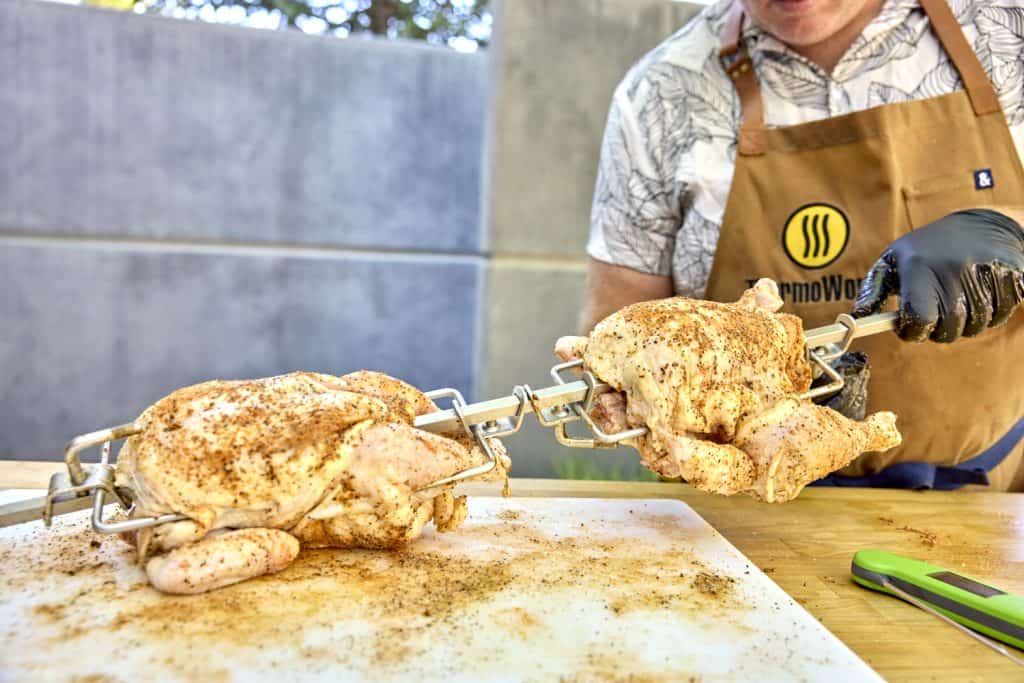
Then set it in your rotisserie and start it up! Because juices and fat will be leaking out of this bird, you can position a drip tray underneath it. This can prevent flare-ups, but will also decrease the grilled flavor. If you have a rotisserie burner at the top back of your grill, only use it for the first ten minutes of cooking, then shut it off. It serves to jump-start the rendering of the fat and the browning of the skin, but keeping it on through the whole cook is too much direct, high heat. If you’re using a live-fire rotisserie, use high, direct heat at first, then raise the rotisserie to finish the bird.
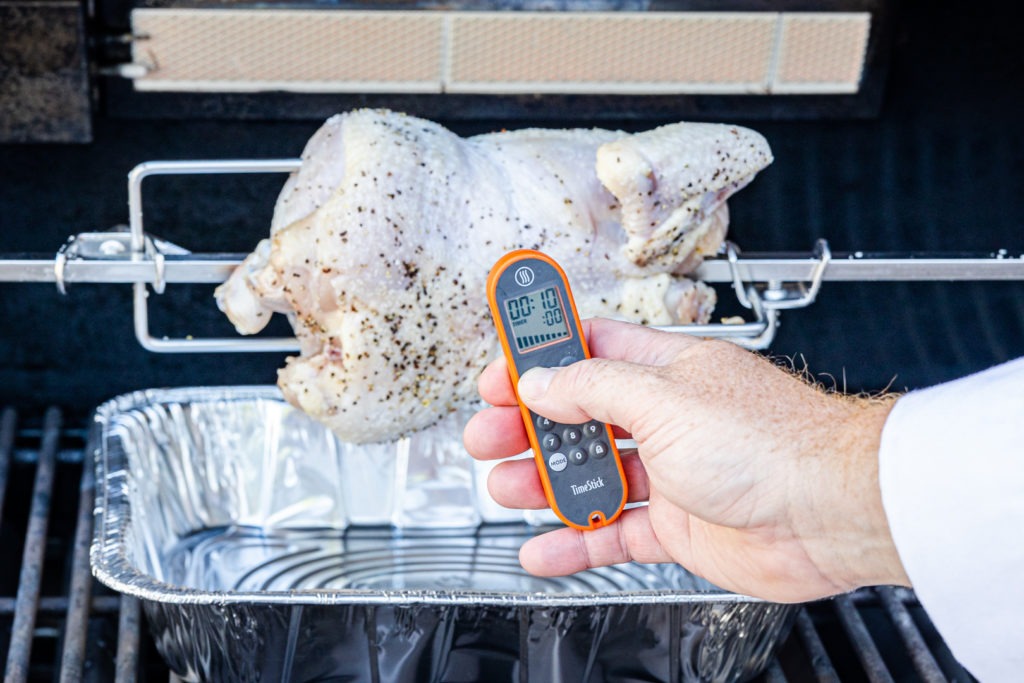
Temping a rotisserie chicken
To temp a rotisserie chicken, turn off the rotisserie and use a Thermapen® to check both the breast and the legs. It’s so easy. Start temping when the chicken has been cooking for about 12–15 minutes per pound, then about every 5 minutes after that. If the chicken’s lowest temperature reads 157°F (69°C), get that chicken off the grill! The meat will continue to carry-over cook for a couple minutes, so get it off the heat before 160°F (71°C) or the breasts will dry out. The skin will be crisp, the meat will be juicy, and it will be delicious. Carve it up and dig in!
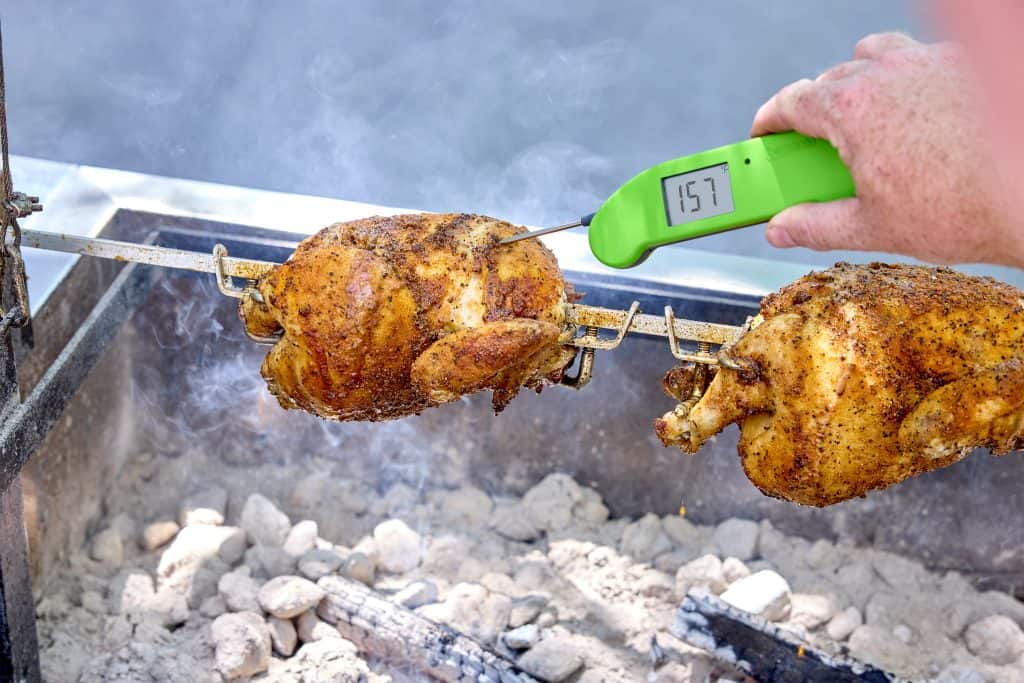
Recap:
- Season your chicken how you like, but seasoning it simply will be just fine.
- Let it sit on the counter with a bag of ice on the breasts for a half-hour before cooking.
- Preheat your grill properly before cooking and prepare it for a high-but-indirect heat. If cooking over open flame, have the flames almost licking the chicken, but not quite.
- Temp your chicken with a Thermapen starting at about 12–15 minutes per pound of chicken.
- Cook your bird to 157°F (69°C). The breasts should be cooler than the thighs because of the icing, so the lowest temp in the whole bird ought to be in the breast.
- Enjoy!
With some thermal thinking and some careful monitoring via the Thermapen ONE, you can have the best rotisserie chicken you’ve ever had. Enjoy the summer!
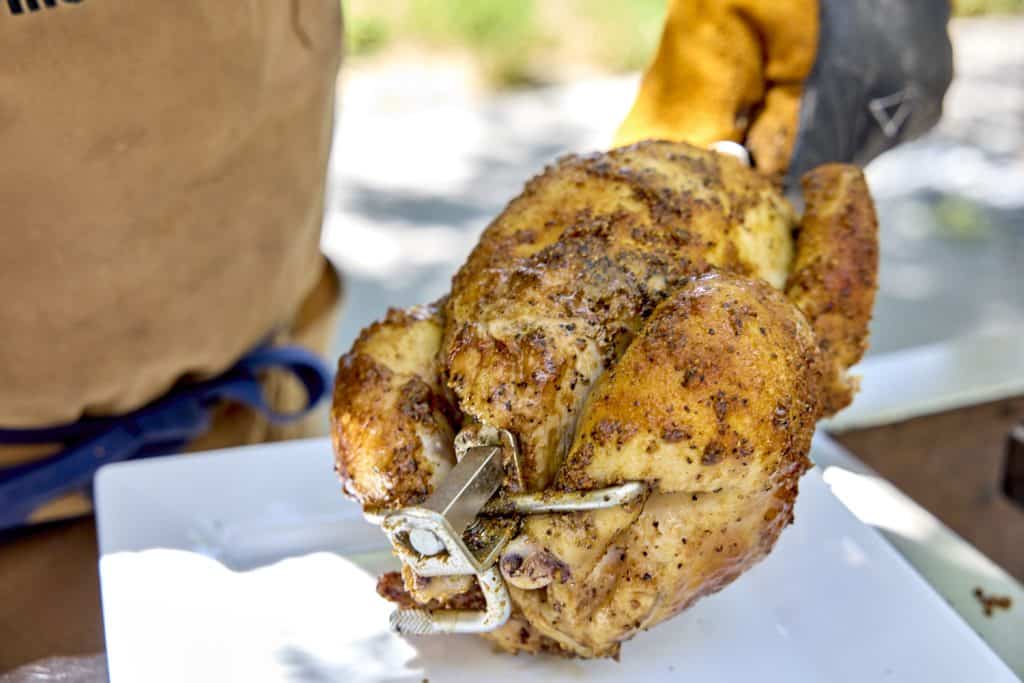


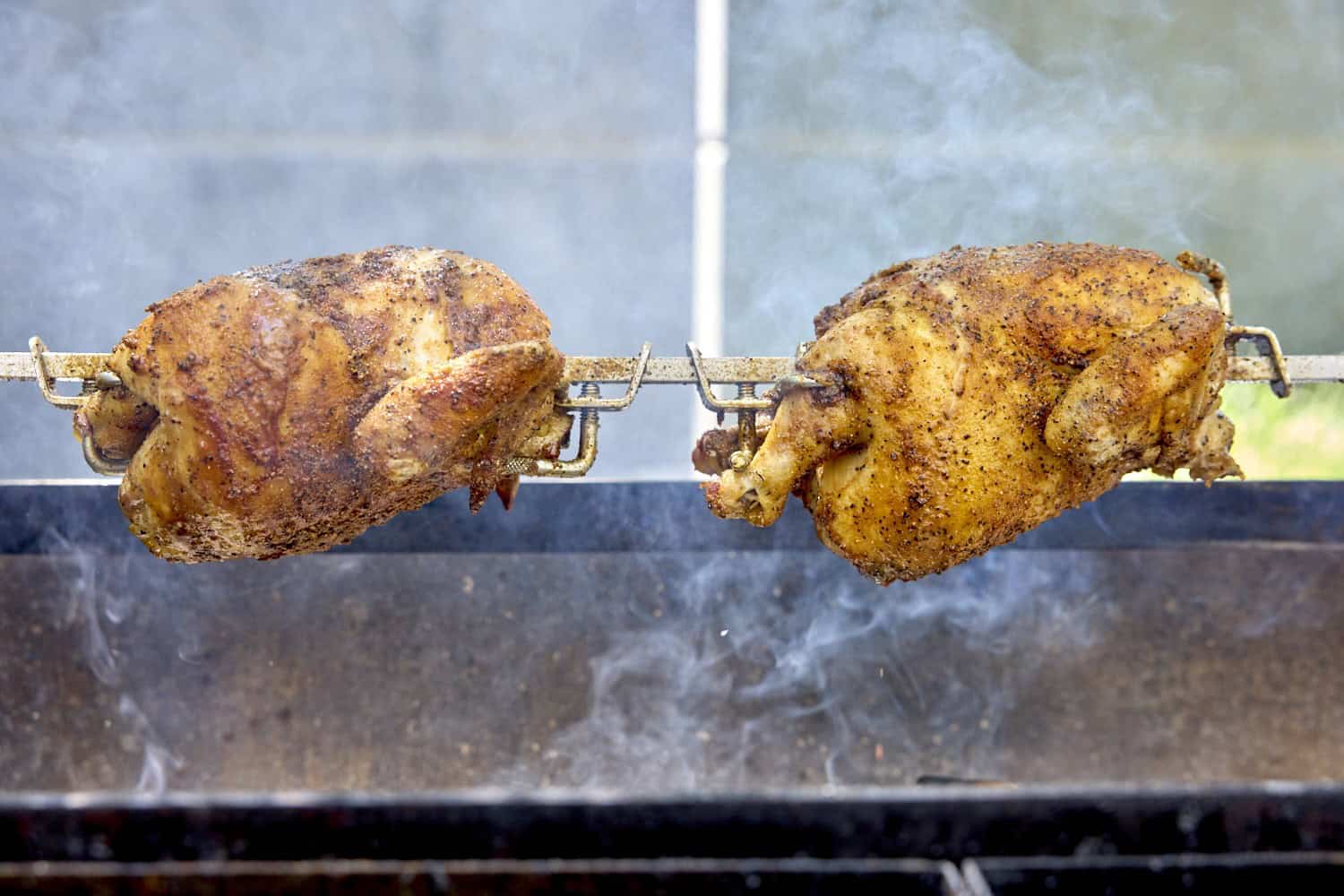
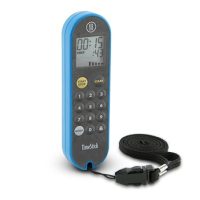
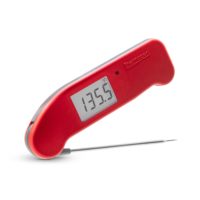
I set up the Chicken on the rotisserie over a disposable pan with a basting sauce, 1 bottle beer (cheap beer is fine, the Chicken doesn’t care), 1 stick butter and salt/pepper. My grill is a Weber Spectrum with an infrared burner which lets me use the main burners in an indirect cook.
Cooking time is 90 minutes, which usually gets to temp, basting every 20 minutes or so. Adjust the infrared burner to get a skin brown without burning.
Sounds awesome!! Question: my grill has a rotisserie burner in the middle of the back, and of the three burners the far left is a sear burner and the two right are regular.
If I am to use that rotisserie burner for only 10 minutes, should both right burners be run at medium? One end on my bird would be partially over the middle burner. What ambient temp are we aiming for inside the grill?
We want an ambient temp probably between 350°F ande 375°F. If if you can move the chicken to the right a little bit when you’re done with the back burner and leave the right burner off, that might help. Otherwise, I think it will probably be ok. just maybe have the burner closest to it turned down a bit more.
Interesting! Thanks.
I like the icing idea for the breasts to start at a cooler temp than the legs – good thinking!
I have a different trick to get to basically the same place (perfectly cooked at both ends)…
I have a Kamado Joe ‘Big Joe’ with the Joetisserie (rotisserie), which is big enough to do 2 chickens at one (which is a lifesaver for weekdays). My tricks here are…
1. load the birds on the spit so the breasts are on the outside and the legs are on the inside
2. For charcoal wall, put more at the center point and less towards the edges. Cooks the breasts with a little less heat.
3. Do not truss the legs – they cook a LOT faster and more evenly than when trussed
4. Load the birds ‘1 face up, 1 face down’ so they are balanced on the spit
5. Do not stuff the cavity
Keep the grill at 325F and it take about an hour – maybe a little less.
BTW, for seasoning I mix softened butter and olive oil, salt, pepper, fresh garlic lemon zest and fresh thyme in a mini food processor and push under the skin, on the skin and, if there’s any left, inside the cavity. Delicious!
For the charcoal wall, does putting more in the center slow the fire down? I’m trying to see how it will be cooler there. I have same Joe set up, just big Joe.
Thanks!
There is only 1 way to get perfect chicken, and a rotisserie is not one of them..!!
Everyone knows the temp differences of the meat, and doing the chicken parts individually as dark and light temps, is the only way to get the finest results possible.!! A properly baked pan(s) of individual parts properly brined and seasoned, will give you exactly what everyone wants.!! Grilling, spatchcock, smoking, or any other whole bird cooking method is inferior.!! yes, you still need a thermometer, and yours are best, no doubt..!! But if you want the best crispy skinned, perfectly seasoned, juicy, can’t get enough of this prime poultry flavor, multi use good “Cluck” charm of an absolute Staple meal, it must be oven baked in separate pieces..!! Not sure…have doubts…I will put my method up against any chef you prefer, any time anywhere.!!
The challenge is up to you.!!
Parting out the chicken so that individual pieces can be perfectly cooked to their target temperature IS the best way to ensure that every piece is perfect, absolutley! But There is a joy to a rotisserie chicken that is special in its own way.
Standing up (rack) 2 chickens on a Weber charcoal grill produce excellent results! I start to check temp at 1 hr, take off at 160, breasts. Legs closer to heat, cook to about 178. Good tip on ice bags, will try next time.
OK what am I doing wrong every time I roast a chicken which is about three all the fat and Juices builds up inside The cavity and tastes very greasy
Are you talking about roasting in the oven or on a rotisserie? In the oven, you are doing nothing wrong. It’s just part of roasting a whole chicken. You can avoid it by spatchcocking the chicken, which will also speed up the cooking, or you could prop the chicken up a little so that the juices run out of the cavity as it cooks. Use some carrots or onions to prop up one end and you’ll get a smaller pool inside.
I can’t see that happening on a rotisserie…
Love my thermopens and wand thermometer. Have already purchased thermopens as gifts.
My new Weber E-335 has little clearance between chicken and flavorizer bars. I need to use a large enough disposable drip pan on the bars so that chicken can rotate freely. I wish Weber had raised the motor and skewer suspension a little to allow leaving grills in place.
Gary,
If your flavorizer bars come in sections you could take the section under the chicken out, which might give you enough clearance. But clearance is a problem it sounds like!
i remove the center flavorizer bar prior to heating and then place my drip pan directly on the turned off burner prior to adding my turkey. have been able to get away with placing the pan directly on the flavorizer bar as long as my chicken is no more than 6 lbs and trussed. if the trussing ends up being too loose for any section once the spit starts to rotate, i add an extra “truss” allowing the spit to help set the string, then pausing the spit to tie.
Do you leave the lid open and closed???????? My new grill states in the instructions to never leave the lid closed for more than 10 minutes.
Cliff,
Do follow your manufacturer’s instructions, of course, but we left the lid closed during the cook, even for the portion with the rotisserie burner turned on. Then we turned that burner off and continued the cook, checking the temps every few minutes.
I make rotisserie chicken all the time but struggle to get crispy skin. I use the rotisserie attachment on my gas grill and the infrared burner. I usually use just the infrared burner through the entire cooking cycle. I’ve tried turning it off after 10 minutes but get basically the same result. Does anybody have any good tips for crispy skin?
Mark,
You might try turning the rotisserie burner on for the last ten minutes to crisp the skin up.
Can i go for a yoghurt based seasoning? i want to give it tandoori chicken flavor as most of the guests are from local area and they love spices.
Of course! That’d be delicious.
So, my girlfriend grew up in Peru and the national dish is Pollo a la Brassa. (Marinade can be purchased in most Latin Farmers Markets.) Delicious but I did not have a rotisserie for my Akorn Char Griller. What I have done is purchased an aftermarket 22 1/2″ rotisserie sold for the Weber grills. I had to use a cut off wheel on my hand held grinder to slit open the ring and shrink it down in diameter just a little. (have pop riveted the overlap of the shrunken ring) now it fits perfectly. I removed the Akorn hinged top and it sits perfectly on top. Debating whether to add height pieces to the rear mounted hinge and leave the ring as a permanent attachment. It does still allow for grate removal and loading of lump charcoal with it in place. Will be trying it today, with two chickens.
Fantastic!